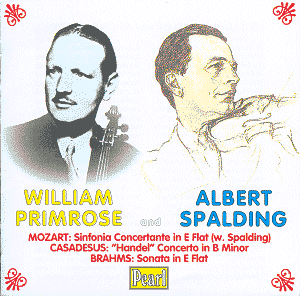William Primrose is here represented by three works
- putatively at least – from different eras. The Casadesus was for many
years attributed to Handel and is a waggish and enjoyable forgery along
the lines of his Bach concerto, supposedly high-Baroque in its appeal.
The Sinfonia Concertante is Mozart’s greatest string concerto and a
high point of Classical literature whilst the Brahms is a romantic masterpiece.
Moreover these performances date from 1937-41, which
is to say from the time of Primrose’s joining Toscanini’s NBC Symphony
Orchestra as co-principal (he was always particular about this – he
was never principal) having recently left the viola chair of the temporarily
disbanded London String Quartet. As such they represent the relatively
early Primrose, different both tonally and in matters of tensile strength
from the performer who was to become so well known as the colleague
of Heifetz and Piatigorsky.
In Casadesus’s jolly piece we can hear Primrose’s excellent
articulation; in the Andante we can also hear the much under-rated Walter
Goehr marshalling his chamber forces to good effect – most noticeably
the woodwind. The finale is nicely pointed and humorous – though surely
not the Allegro molto energico as marked. His great predecessor, Lionel
Tertis, would never have been so circumspect.
In fact it was Tertis, with his colleagues Sammons
and Hamilton Harty and the LPO, who had made the first recording of
the Sinfonia Concertante against which this Spalding-Primrose-Stiedry
performance was for many years judged. It is a real pity that such poor
copies have been used in this issue and that the scratch that bedevils
the entire concerto has not been dealt with. The original discs are
not so rare that a clean set could not have been found. There is also
a truly horrible side join at 8.42 in the first movement that cripples
momentum. We can also hear Primrose splitting a note at 3.02 in this
movement and listen to Albert Spalding’s famously electric trill, and
a degree of orchestral clarity, if not always tidiness. Listen, nevertheless,
to the well brought out horn writing and the way Fritz Stiedry – another
under rated conductor – shapes the movement. The cadenza is especially
well played. In the Andante we can especially hear the great classicist
Spalding’s clarity of articulation and tonal shading. Does he speed
up after the side change at 3.30? There’s a palpable tempo increase.
There is much distinguished playing from both soloists though arguably
nothing quite so deeply moving as that achieved in their different way
by Sammons and Tertis. In the buoyant finale Spalding and Primrose observe
the stylistic niceties far better than Sammons and Tertis whose massive
rallentando is an exercise in Edwardian piety and it is interesting
to hear Spalding very slightly lengthen his note values. Orchestral
counterpoint is nicely achieved by Stiedry. Whilst it is unarguably
the case that this is the finest of Primrose’s recordings of the Concertante
– his recording with Heifetz was an unseemly dash and that with Stern
and Casals an interminable wallow – and also that his and Spalding’s
techniques are perhaps more fluent and their concept more streamlined
I find this performance emotionally less intense than the Sammons-Tertis-Harty,
for all its faults, and less enjoyable.
The Brahms Sonata recording with Gerald Moore is the
most well known of the three recordings on this disc and the best. Though
Primrose was later to re-record it with Rudolf Firkusny that was a faster
and less obviously affectionate performance, notwithstanding the unambiguous
excellent of both musicians. With Moore an ever understanding and sympathetic
partner the Andante con moto is especially beautiful and the work is
suffused with Primrose’s exercise of tonal shading and his well-chosen
tempi. A performance to savour.
With the limitations as noted above then this is a
good conspectus of the pre-Heifetz Primrose.
Jonathan Woolf


